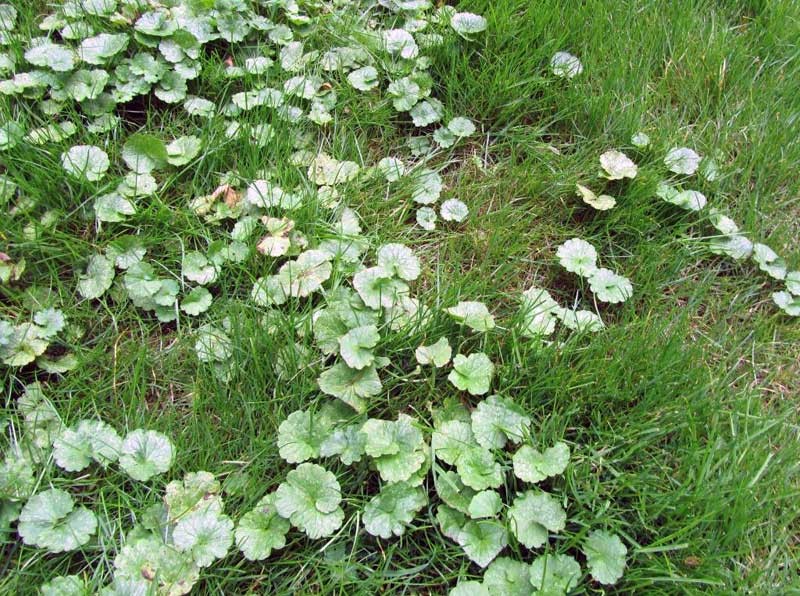
Every spring, we receive hundreds of calls from frustrated homeowners wondering about Creeping Charlie (aka; ground ivy), how to get rid of it, and why it just won’t go away! It is an incredibly persistent weed (for a variety of reasons that we’ll cover later), and even the most knowledgeable lawn care professionals have struggled for years battling it. Even if someone does everything right, it can still pop up from time to time. The keys to treating it and eliminating it are consistency and persistence! Get a satellite quote from us today to get some professional help.
Identification of Creeping Charlie
Creeping charlie is difficult to mistake for something else, but it’s always good to get a better understanding of the enemy. Properly identifying it will also give us a chance to examine the traits that make it so difficult to control. Creeping charlie is a member of the mint family, and it does have that very distinct odor. The leaf is rounded with lobed edges, with small purple flowers blooming occasionally throughout the growing season. As the name suggests, it grows aggressively outward and spreads by way of horizontal roots called rhizomes. These rhizomes will sprout new leaves and roots periodically, so one plant can give rise to dozens.

Another characteristic that makes Creeping Charlie difficult to control is the leaves themselves. They have a waxy coating that makes it more difficult for pesticides to be absorbed. There are certain products that are more effective in dealing with this feature, and we’ll discuss that when we talk about methods of controlling this weed.
Controlling Creeping Charlie on Iowa Lawns
Achieving complete, 100% of creeping charlie is extremely difficult. So much so, that we never fully guarantee that we can rid a lawn of it! As mentioned earlier, the two keys are persistence and consistency. Regular treatments are imperative in gaining ground, and we must continue that diligence year to year. As mentioned earlier, certain chemical products are more effective than others. Some products act quickly, which is great for seeing instant results. The downside is that these products metabolize quickly, and complete control may not be achieved. With Creeping Charlie having such an extensive root system, and leaves that tend to repel moisture, a product that stays on the plant and persists in the stems and roots is a necessity. At UltraLawn, we utilize a blend of products to maximize a broad range of compounds that are effective on a wide variety of broadleaf weeds. We alter our regime to fit existing weather conditions and to ensure we’re using the best chemistry in the right conditions. We are limited to how much product we can use and the timing of such use, so we are always conscious of these factors as well. The best time of year to treat Creeping Charlie is in the fall. Plants naturally shift more of their energy to building roots in the fall. Chemical products are most effective at this time as we need to eliminate the “root” of the problem. Plants take quick drinks in the spring and summer, but nice long gulps in the fall!
One question we are asked is regarding pre-emergent control of Creeping Charlie. The vast majority of pre-emergents are geared toward preventing grassy weeds like crabgrass and foxtail. Some broadleaf weeds are suppressed in the meantime, but Creeping Charlie can’t be completely prevented with a spring pre-emergent. Grassy weeds have a short window in which they thrive, making them easier to prevent. Creeping Charlie survives and persists over a wide range of conditions.
In some cases, a brave soul will try pulling and digging Creeping Charlie to get rid of it once and for all. Even though every single round leaf may be pulled and disposed of, the odds are very low that complete control of the weed has been achieved. As mentioned earlier, creeping charlie spreads through a tough system of underground roots called rhizomes. It is extremely difficult (if not impossible) to get every piece of these roots, and if a small piece is left in the ground, it has the potential to regenerate new growth. Another thing to consider is that Creeping Charlie can encroach from a neighboring property. By law, we can’t treat across property lines. But we can leave our information behind for a neighbor to consider!
Part of maintaining a healthy lawn involves proper mowing (see our blog post about mowing for some great information!). When lawns are mowed too short, it weakens the turf and allows more sunlight to reach the soil. Since Creeping Charlie has a very low growing habit, we want to limit how much sunlight is making it down to the leaves. Anything we can do to make the turf healthier will help keep weeds at bay!
If you have any questions or concerns about your lawn, feel free to give UltraLawn a call! We’ve been helping grow fantastic lawns for over 35 years, and look forward to the opportunity to helping you as well!

No comment yet, add your voice below!